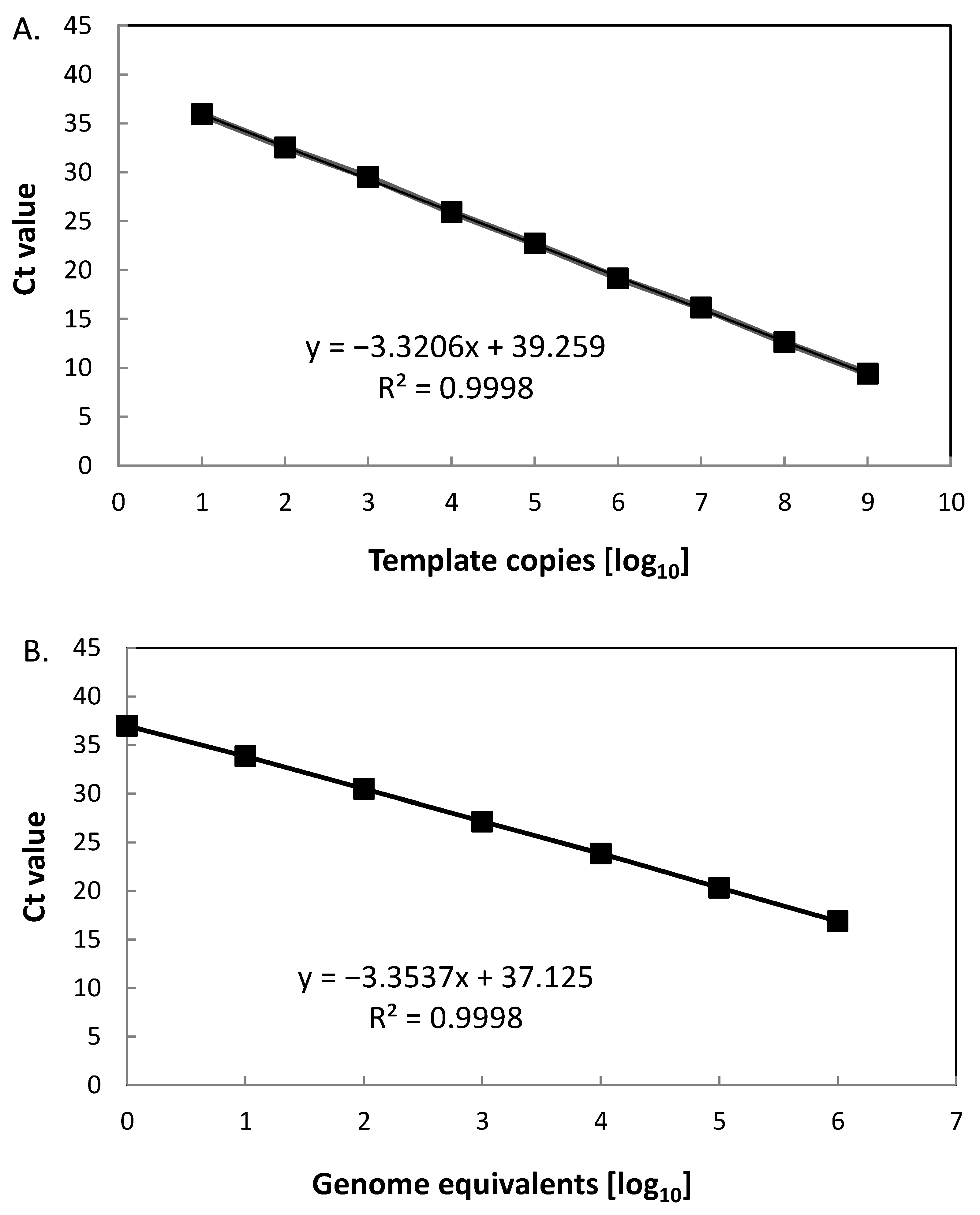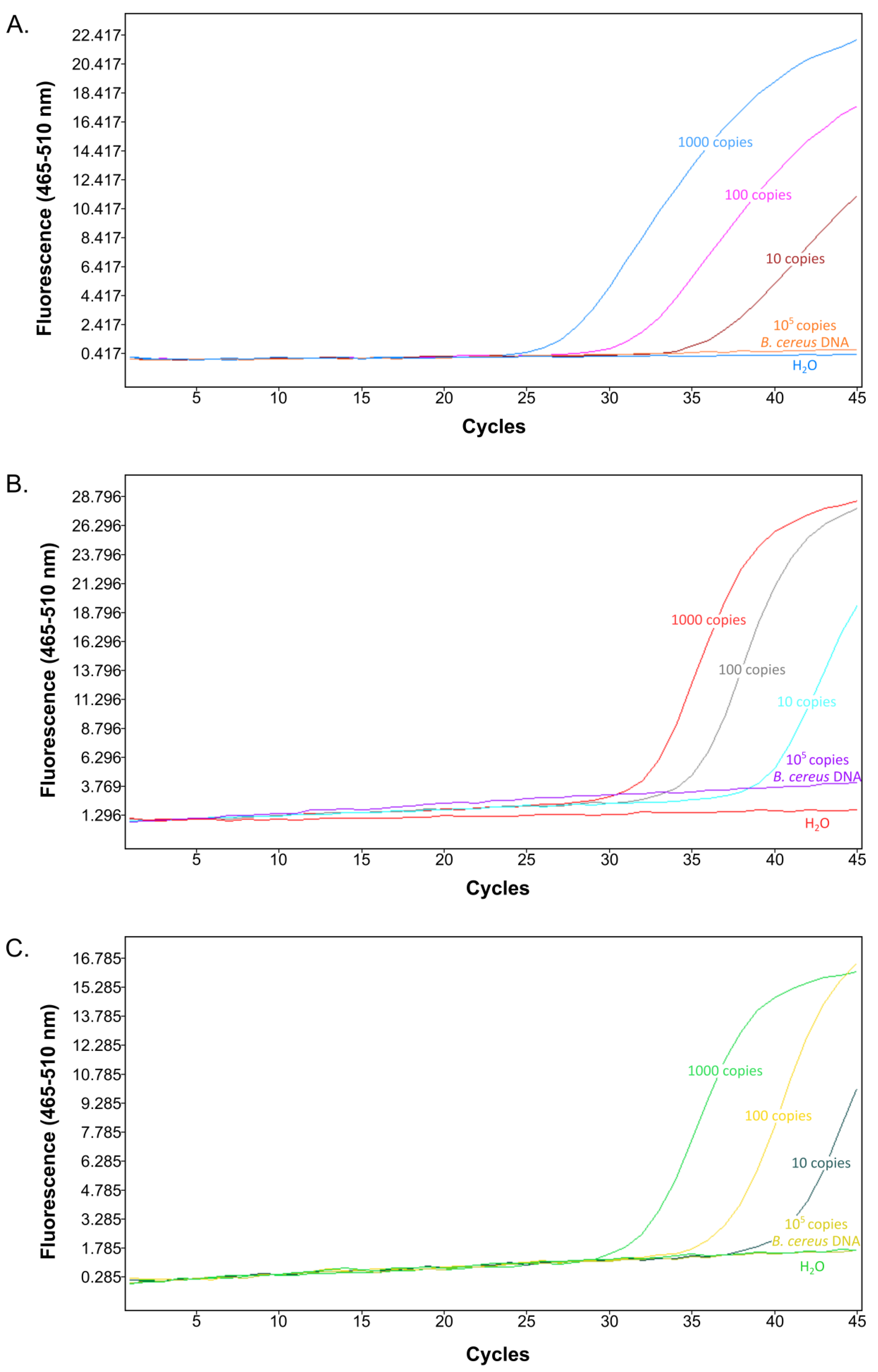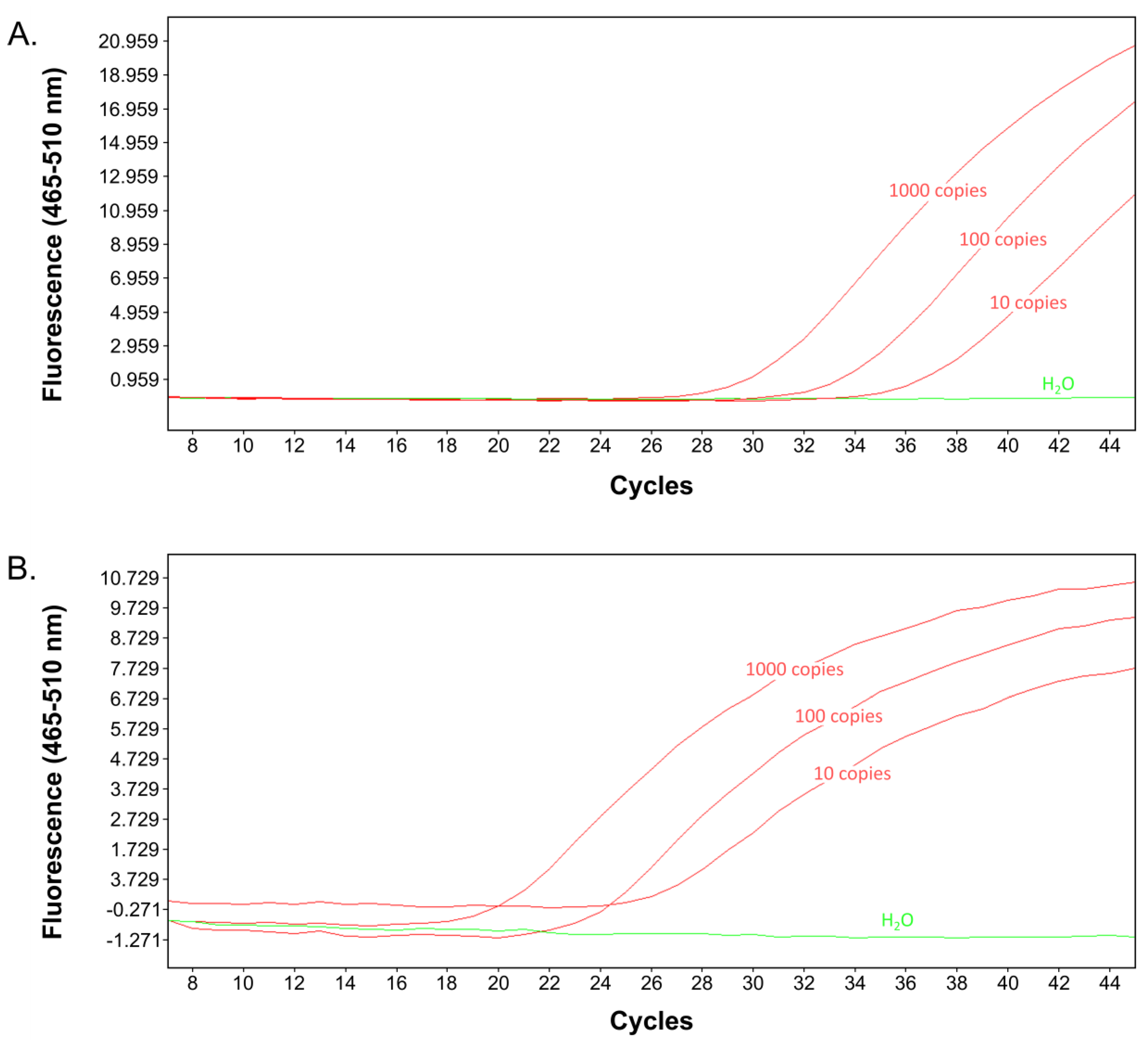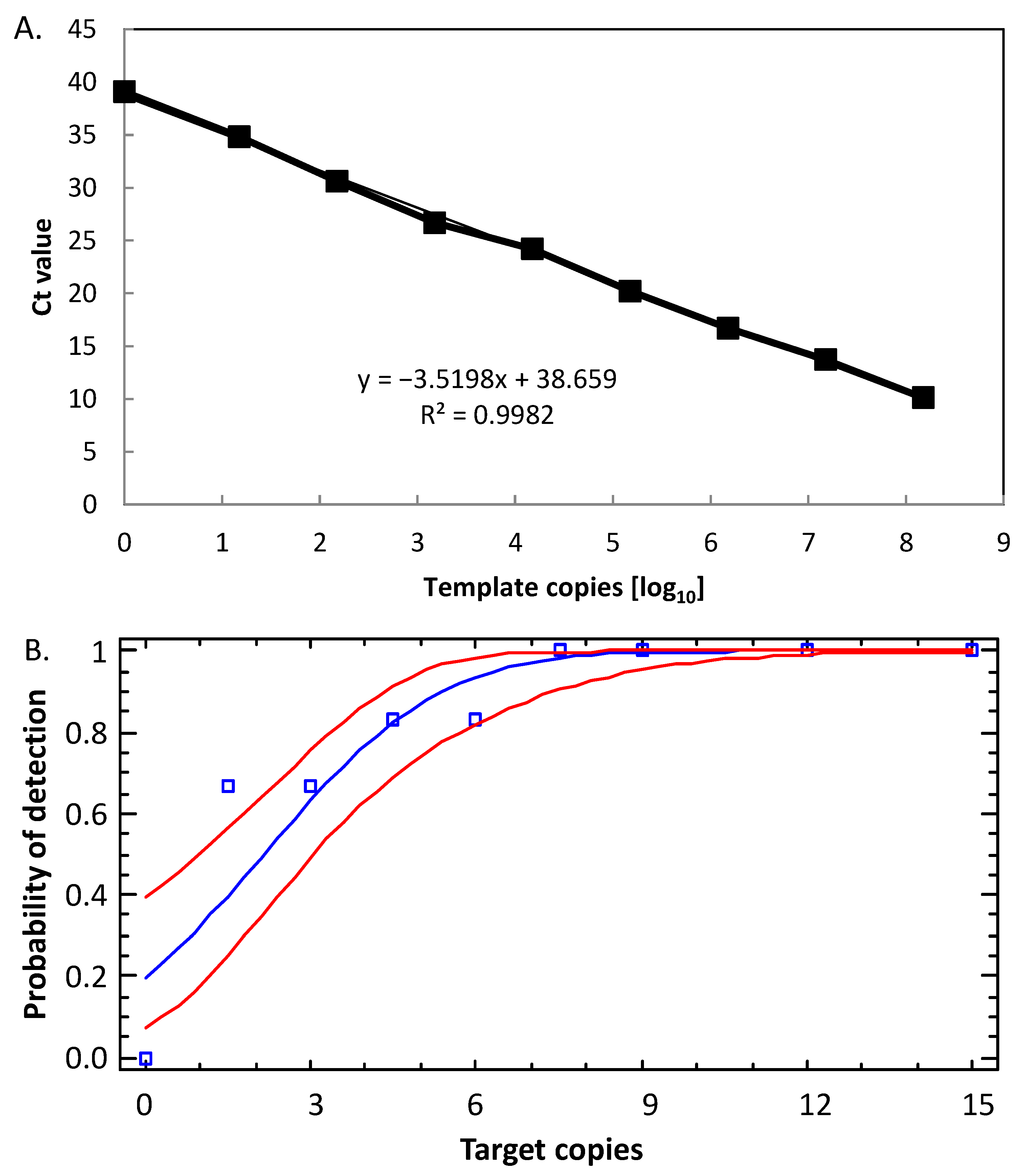Ultrasensitive Detection of Bacillus anthracis by Real-Time PCR Targeting a Polymorphism in Multi-Copy 16S rRNA Genes and Their Transcripts
Abstract
1. Introduction
2. Results
2.1. Set-Up and Optimization of a New 16S rRNA Gene Allele-Specific PCR Assay
2.2. Competitive Amplification-Inhibition of the 16S-BA-Allele Fragment-PCR by Excess of the Alternative 16S-BC-Allele
2.3. Sensitivity and Specificity of the 16S rRNA SNP-PCR Assay
2.4. Linear Dynamic Range, Efficiency, and Limit of Detection of the B. anthracis Specific 16S rRNA SNP-PCR Assay
2.5. Comparison of the New 16S rRNA SNP-PCR Assay with Existing PCR Assays
2.6. Challenge of the New 16S rRNA SNP-PCR Assay with Samples from a Ring Trial
2.7. Challenge of the New 16S rRNA SNP-PCR Assay with Total DNA from Spiked Soil Samples
2.8. The New 16S rRNA SNP-PCR Assay also Functions as an RT-PCR Assay
2.9. Linear Dynamic Range, Efficiency, and Limit of Detection of the B. anthracis 16S rRNA SNP RT-PCR Assay
3. Materials and Methods
3.1. Bacterial Culture, Inactivation, and DNA Samples for Quality Assessment
3.2. Isolation of DNA, RNA, and Nucleic Acid Quantification
3.3. Design and in Silico Bioinformatic Analysis of Primer and Probe DNA Sequences
3.4. Real-Time and Reverse Transcription PCR Conditions
3.5. Droplet Digital PCR (ddPCR) and Reverse Transcription (RT) ddPCR
3.6. Generation of PCR Positive Controls from Reference Plasmids Harboring 16S-BA- or BC-Allele Fragments
3.7. Determination of the Specificity (Inclusivity/Exclusivity) of the B. anthracis 16S rRNA Allele Assay
3.8. Dynamic Linear Range, PCR Efficiency, and Limit of Detection
4. Discussion
5. Conclusions
Supplementary Materials
Author Contributions
Funding
Institutional Review Board Statement
Informed Consent Statement
Data Availability Statement
Acknowledgments
Conflicts of Interest
References
- Turnbull, P.C.; World Health Organization. Anthrax in Humans and Animals; Turnbull, P., Ed.; WHO Press: Geneva, Switzerland, 2008. [Google Scholar]
- Ehling-Schulz, M.; Lereclus, D.; Koehler, T.M. The Bacillus cereus group: Bacillus species with pathogenic potential. Microbiol. Spectr. 2019, 7. [Google Scholar] [CrossRef]
- Mock, M.; Fouet, A. Anthrax. Annu. Rev. Microbiol. 2001, 55, 647–671. [Google Scholar] [CrossRef] [PubMed]
- Jelacic, T.M.; Chabot, D.J.; Bozue, J.A.; Tobery, S.A.; West, M.W.; Moody, K.; Yang, D.; Oppenheim, J.J.; Friedlander, A.M. Exposure to Bacillus anthracis capsule results in suppression of human monocyte-derived dendritic cells. Infect. Immun. 2014, 82, 3405–3416. [Google Scholar] [CrossRef] [PubMed]
- Patino-Navarrete, R.; Sanchis, V. Evolutionary processes and environmental factors underlying the genetic diversity and lifestyles of Bacillus cereus group bacteria. Res. Microbiol. 2017, 168, 309–318. [Google Scholar] [CrossRef]
- Wielinga, P.R.; Hamidjaja, R.A.; Ågren, J.; Knutsson, R.; Segerman, B.; Fricker, M.; Ehling-Schulz, M.; de Groot, A.; Burton, J.; Brooks, T.; et al. A multiplex real-time PCR for identifying and differentiating B. anthracis virulent types. Int. J. Food Microbiol. 2011, 145, S137–S144. [Google Scholar] [CrossRef] [PubMed]
- Ellerbrok, H.; Nattermann, H.; Ozel, M.; Beutin, L.; Appel, B.; Pauli, G. Rapid and sensitive identification of pathogenic and apathogenic Bacillus anthracis by real-time PCR. FEMS Microbiol. Lett. 2002, 214, 51–59. [Google Scholar] [CrossRef]
- Ramisse, V.; Patra, G.; Garrigue, H.; Guesdon, J.L.; Mock, M. Identification and characterization of Bacillus anthracis by multiplex PCR analysis of sequences on plasmids pXO1 and pXO2 and chromosomal DNA. FEMS Microbiol. Lett. 1996, 145, 9–16. [Google Scholar] [CrossRef]
- Antwerpen, M.H.; Zimmermann, P.; Bewley, K.; Frangoulidis, D.; Meyer, H. Real-time PCR system targeting a chromosomal marker specific for Bacillus anthracis. Mol. Cell. Probes 2008, 22, 313–315. [Google Scholar] [CrossRef]
- Easterday, W.R.; Van Ert, M.N.; Simonson, T.S.; Wagner, D.M.; Kenefic, L.J.; Allender, C.J.; Keim, P. Use of single nucleotide polymorphisms in the plcR gene for specific identification of Bacillus anthracis. J. Clin. Microbiol. 2005, 43, 1995–1997. [Google Scholar] [CrossRef]
- Ågren, J.; Hamidjaja, R.A.; Hansen, T.; Ruuls, R.; Thierry, S.; Vigre, H.; Janse, I.; Sundström, A.; Segerman, B.; Koene, M.; et al. In silico and in vitro evaluation of PCR-based assays for the detection of Bacillus anthracis chromosomal signature sequences. Virulence 2013, 4, 671–685. [Google Scholar] [CrossRef]
- Straub, T.; Baird, C.; Bartholomew, R.A.; Colburn, H.; Seiner, D.; Victry, K.; Zhang, L.; Bruckner-Lea, C.J. Estimated copy number of Bacillus anthracis plasmids pXO1 and pXO2 using digital PCR. J. Microbiol. Methods 2013, 92, 9–10. [Google Scholar] [CrossRef]
- Pena-Gonzalez, A.; Rodriguez-R, L.; Marston, C.K.; Gee, J.E.; Gulvik, C.A.; Kolton, C.B.; Saile, E.; Frace, M.; Hoffmaster, A.R.; Konstantinidis, K.T. Genomic characterization and copy number variation of Bacillus anthracis plasmids pXO1 and pXO2 in a historical collection of 412 strains. mSystems 2018, 3, e00065-18. [Google Scholar] [CrossRef]
- Hansen, M.C.; Nielsen, A.K.; Molin, S.; Hammer, K.; Kilstrup, M. Changes in rRNA levels during stress invalidates results from mRNA blotting: Fluorescence in situ rRNA hybridization permits renormalization for estimation of cellular mRNA levels. J. Bacteriol. 2001, 183, 4747–4751. [Google Scholar] [CrossRef]
- Bremer, H.; Dennis, P.P. Modulation of chemical composition and other parameters of the cell at different exponential growth rates. EcoSal Plus 2008, 3. [Google Scholar] [CrossRef] [PubMed]
- Wiśniewski, J.R.; Rakus, D. Multi-enzyme digestion FASP and the ‘Total Protein Approach’-based absolute quantification of the Escherichia coli proteome. J. Proteom. 2014, 109, 322–331. [Google Scholar] [CrossRef] [PubMed]
- van Dijk-Salkinoja, M.S.; Planta, R.J. Rate of ribosome production in Bacillus licheniformis. J. Bacteriol. 1971, 105, 20–27. [Google Scholar] [CrossRef] [PubMed]
- Barrera, A.; Pan, T. Interaction of the Bacillus subtilis RNase P with the 30S ribosomal subunit. RNA 2004, 10, 482–492. [Google Scholar] [CrossRef]
- Matsuda, K.; Tsuji, H.; Asahara, T.; Kado, Y.; Nomoto, K. Sensitive quantitative detection of commensal bacteria by rRNA-targeted reverse transcription-PCR. Appl. Environ. Microbiol. 2007, 73, 32–39. [Google Scholar] [CrossRef]
- Beissner, M.; Symank, D.; Phillips, R.O.; Amoako, Y.A.; Awua-Boateng, N.Y.; Sarfo, F.S.; Jansson, M.; Huber, K.L.; Herbinger, K.H.; Battke, F.; et al. Detection of viable Mycobacterium ulcerans in clinical samples by a novel combined 16S rRNA reverse transcriptase/IS2404 real-time qPCR assay. PLoS Negl. Trop. Dis. 2012, 6, e1756. [Google Scholar] [CrossRef]
- Beissner, M.; Woestemeier, A.; Saar, M.; Badziklou, K.; Maman, I.; Amedifou, C.; Wagner, M.; Wiedemann, F.X.; Amekuse, K.; Kobara, B.; et al. Development of a combined RLEP/16S rRNA (RT) qPCR assay for the detection of viable M. leprae from nasal swab samples. BMC Infect. Dis. 2019, 19, 753. [Google Scholar] [CrossRef]
- Ash, C.; Farrow, J.A.; Dorsch, M.; Stackebrandt, E.; Collins, M.D. Comparative analysis of Bacillus anthracis, Bacillus cereus, and related species on the basis of reverse transcriptase sequencing of 16S rRNA. Int. J. Syst. Bacteriol. 1991, 41, 343–346. [Google Scholar] [CrossRef] [PubMed]
- Candelon, B.; Guilloux, K.; Ehrlich, S.D.; Sorokin, A. Two distinct types of rRNA operons in the Bacillus cereus group. Microbiology 2004, 150 Pt 3, 601–611. [Google Scholar] [CrossRef]
- Hakovirta, J.R.; Prezioso, S.; Hodge, D.; Pillai, S.P.; Weigel, L.M. Identification and analysis of informative single nucleotide polymorphisms in 16S rRNA gene sequences of the Bacillus cereus group. J. Clin. Microbiol. 2016, 54, 2749–2756. [Google Scholar] [CrossRef] [PubMed]
- Braun, P.; Zimmermann, F.; Walter, M.C.; Mantel, S.; Aistleitner, K.; Stürz, I.; Grass, G.; Stoecker, K. In-depth analysis of Bacillus anthracis 16S rRNA genes and transcripts reveals intra- and intergenomic diversity and facilitates anthrax detection. bioRxiv 2021. [Google Scholar] [CrossRef]
- Irenge, L.M.; Durant, J.F.; Tomaso, H.; Pilo, P.; Olsen, J.S.; Ramisse, V.; Mahillon, J.; Gala, J.L. Development and validation of a real-time quantitative PCR assay for rapid identification of Bacillus anthracis in environmental samples. Appl. Microbiol. Biotechnol. 2010, 88, 1179–1192. [Google Scholar] [CrossRef] [PubMed]
- Sahl, J.W.; Pearson, T.; Okinaka, R.; Schupp, J.M.; Gillece, J.D.; Heaton, H.; Birdsell, D.; Hepp, C.; Fofanov, V.; Noseda, R.; et al. A Bacillus anthracis genome sequence from the Sverdlovsk 1979 autopsy specimens. mBio 2016, 7, e01501-16. [Google Scholar] [CrossRef]
- Antwerpen, M.; Beyer, W.; Bassy, O.; Ortega-García, M.V.; Cabria-Ramos, J.C.; Grass, G.; Wölfel, R. Phylogenetic placement of isolates within the Trans-Eurasian clade A.Br.008/009 of Bacillus anthracis. Microorganisms 2019, 7, 689. [Google Scholar] [CrossRef]
- Kämpfer, P.; Busse, H.J.; McInroy, J.A.; Glaeser, S.P. Sphingomonas zeae sp. nov., isolated from the stem of Zea mays. Int. J. Syst. Evol. Microbiol. 2015, 65, 2542–2548. [Google Scholar] [CrossRef][Green Version]
- Reischl, U.; Ehrenschwender, M.; Hiergeist, A.; Maaß, M.; Baier, M.; Frangoulidis, D.; Grass, G.; von Buttlar, H.; Scholz, H.; Fingerle, V.; et al. Bacterial and fungal genome detection PCR/NAT: Comprehensive discussion of the June 2018 distribution for external quality assessment of nucleic acid-based protocols in diagnostic medical microbiology by INSTAND e.V., GMS Z Forder Qualitatssich. Med. Lab. 2019, 10, 1869–4241. [Google Scholar]
- Braun, P.; Grass, G.; Aceti, A.; Serrecchia, L.; Affuso, A.; Marino, L.; Grimaldi, S.; Pagano, S.; Hanczaruk, M.; Georgi, E.; et al. Microevolution of anthrax from a young ancestor (M.A.Y.A.) suggests a soil-borne life cycle of Bacillus anthracis. PLoS ONE 2015, 10, e0135346. [Google Scholar]
- Altschul, S.F.; Gish, W.; Miller, W.; Myers, E.W.; Lipman, D.J. Basic local alignment search tool. J. Mol. Biol. 1990, 215, 403–410. [Google Scholar] [CrossRef]
- Koshkin, A.A.; Singh, S.K.; Nielsen, P.; Rajwanshi, V.K.; Kumar, R.; Meldgaard, M.; Olsen, C.E.; Wengel, J. LNA (Locked Nucleic Acids): Synthesis of the adenine, cytosine, guanine, 5-methylcytosine, thymine and uracil bicyclonucleoside monomers, oligomerisation, and unprecedented nucleic acid recognition. Tetrahedron 1998, 54, 3607–3630. [Google Scholar] [CrossRef]
- Perelle, S.; Dilasser, F.; Grout, J.; Fach, P. Detection by 5’-nuclease PCR of Shiga-toxin producing Escherichia coli O26, O55, O91, O103, O111, O113, O145 and O157:H7, associated with the world’s most frequent clinical cases. Mol. Cell. Probes 2004, 18, 185–192. [Google Scholar] [CrossRef] [PubMed]
- Stolovitzky, G.; Cecchi, G. Efficiency of DNA replication in the polymerase chain reaction. Proc. Natl. Acad. Sci. USA 1996, 93, 12947–12952. [Google Scholar] [CrossRef]
- Forootan, A.; Sjöback, R.; Björkman, J.; Sjögreen, B.; Linz, L.; Kubista, M. Methods to determine limit of detection and limit of quantification in quantitative real-time PCR (qPCR). Biomol. Detect. Quantif. 2017, 12, 1–6. [Google Scholar] [CrossRef]
- Nübel, U.; Schmidt, P.M.; Reiß, E.; Bier, F.; Beyer, W.; Naumann, D. Oligonucleotide microarray for identification of Bacillus anthracis based on intergenic transcribed spacers in ribosomal DNA. FEMS Microbiol. Lett. 2004, 240, 215–223. [Google Scholar] [CrossRef][Green Version]
- Daffonchio, D.; Raddadi, N.; Merabishvili, M.; Cherif, A.; Carmagnola, L.; Brusetti, L.; Rizzi, A.; Chanishvili, N.; Visca, P.; Sharp, R.; et al. Strategy for identification of Bacillus cereus and Bacillus thuringiensis strains closely related to Bacillus anthracis. Appl. Environ. Microbiol. 2006, 72, 1295–1301. [Google Scholar] [CrossRef]
- Cherif, A.; Borin, S.; Rizzi, A.; Ouzari, H.; Boudabous, A.; Daffonchio, D. Bacillus anthracis diverges from related clades of the Bacillus cereus group in 16S-23S ribosomal DNA intergenic transcribed spacers containing tRNA genes. Appl. Environ. Microbiol. 2003, 69, 33–40. [Google Scholar] [CrossRef]
- Hadjinicolaou, A.V.; Demetriou, V.L.; Hezka, J.; Beyer, W.; Hadfield, T.L.; Kostrikis, L.G. Use of molecular beacons and multi-allelic real-time PCR for detection of and discrimination between virulent Bacillus anthracis and other Bacillus isolates. J. Microbiol. Methods 2009, 78, 45–53. [Google Scholar] [CrossRef]
- Merrill, L.; Richardson, J.; Kuske, C.R.; Dunbar, J. Fluorescent heteroduplex assay for monitoring Bacillus anthracis and close relatives in environmental samples. Appl. Environ. Microbiol. 2003, 69, 3317–3326. [Google Scholar] [CrossRef]
- Easterday, W.R.; Van Ert, M.N.; Zanecki, S.; Keim, P. Specific detection of Bacillus anthracis using a TaqMan mismatch amplification mutation assay. Biotechniques 2005, 38, 731–735. [Google Scholar] [CrossRef]
- Altayar, M.; Sutherland, A.D. Bacillus cereus is common in the environment but emetic toxin producing isolates are rare. J. Appl. Microbiol. 2006, 100, 7–14. [Google Scholar] [CrossRef] [PubMed]
- Mancilla, M.; Ulloa, M.; López-Goñi, I.; Moriyón, I.; María Zárraga, A. Identification of new IS711 insertion sites in Brucella abortus field isolates. BMC Microbiol. 2011, 11, 176. [Google Scholar] [CrossRef] [PubMed]
- Bounaadja, L.; Albert, D.; Chénais, B.; Hénault, S.; Zygmunt, M.S.; Poliak, S.; Garin-Bastuji, B. Real-time PCR for identification of Brucella spp.: A comparative study of IS711, bcsp31 and per target genes. Veter- Microbiol. 2009, 137, 156–164. [Google Scholar] [CrossRef]
- Klee, S.R.; Tyczka, J.; Ellerbrok, H.; Franz, T.; Linke, S.; Baljer, G.; Appel, B. Highly sensitive real-time PCR for specific detection and quantification of Coxiella burnetii. BMC Microbiol. 2006, 6, 2. [Google Scholar] [CrossRef]
- Backstedt, B.T.; Buyuktanir, O.; Lindow, J.; Wunder, E.A., Jr.; Reis, M.G.; Usmani-Brown, S.; Ledizet, M.; Ko, A.; Pal, U. Efficient detection of pathogenic Leptospires using 16S ribosomal RNA. PLoS ONE 2015, 10, e0128913. [Google Scholar] [CrossRef] [PubMed]
- Kubota, H.; Tsuji, H.; Matsuda, K.; Kurakawa, T.; Asahara, T.; Nomoto, K. Detection of human intestinal catalase-negative, Gram-positive cocci by rRNA-targeted reverse transcription-PCR. Appl. Environ. Microbiol. 2010, 76, 5440–5451. [Google Scholar] [CrossRef] [PubMed]
- Tsuji, H.; Matsuda, K.; Nomoto, K. Counting the countless: Bacterial quantification by targeting rRNA molecules to explore the human gut microbiota in health and disease. Front. Microbiol. 2018, 9, 1417. [Google Scholar] [CrossRef] [PubMed]





| Oligonucleotide | Sequence (5′-3′) |
|---|---|
| 16S SNP F * | CGAGCGCAACCCTTGA |
| 16S SNP R * | CAGTCACCTTAGAGTGCCC |
| 16S SNP BA probe | 6FAM-CTT+AGTT+A+C+C+AT+CATT--BHQ1 |
| 16S SNP BC probe | HEX-CTT+AGTT+G+C+C+ATCATT--BHQ1 |
| Dark 16S SNP BC probe | CTT+AGTT+G+C+C+ATCATT-C3-spacer ** |
Publisher’s Note: MDPI stays neutral with regard to jurisdictional claims in published maps and institutional affiliations. |
© 2021 by the authors. Licensee MDPI, Basel, Switzerland. This article is an open access article distributed under the terms and conditions of the Creative Commons Attribution (CC BY) license (https://creativecommons.org/licenses/by/4.0/).
Share and Cite
Braun, P.; Nguyen, M.D.-T.; Walter, M.C.; Grass, G. Ultrasensitive Detection of Bacillus anthracis by Real-Time PCR Targeting a Polymorphism in Multi-Copy 16S rRNA Genes and Their Transcripts. Int. J. Mol. Sci. 2021, 22, 12224. https://doi.org/10.3390/ijms222212224
Braun P, Nguyen MD-T, Walter MC, Grass G. Ultrasensitive Detection of Bacillus anthracis by Real-Time PCR Targeting a Polymorphism in Multi-Copy 16S rRNA Genes and Their Transcripts. International Journal of Molecular Sciences. 2021; 22(22):12224. https://doi.org/10.3390/ijms222212224
Chicago/Turabian StyleBraun, Peter, Martin Duy-Thanh Nguyen, Mathias C. Walter, and Gregor Grass. 2021. "Ultrasensitive Detection of Bacillus anthracis by Real-Time PCR Targeting a Polymorphism in Multi-Copy 16S rRNA Genes and Their Transcripts" International Journal of Molecular Sciences 22, no. 22: 12224. https://doi.org/10.3390/ijms222212224
APA StyleBraun, P., Nguyen, M. D.-T., Walter, M. C., & Grass, G. (2021). Ultrasensitive Detection of Bacillus anthracis by Real-Time PCR Targeting a Polymorphism in Multi-Copy 16S rRNA Genes and Their Transcripts. International Journal of Molecular Sciences, 22(22), 12224. https://doi.org/10.3390/ijms222212224







